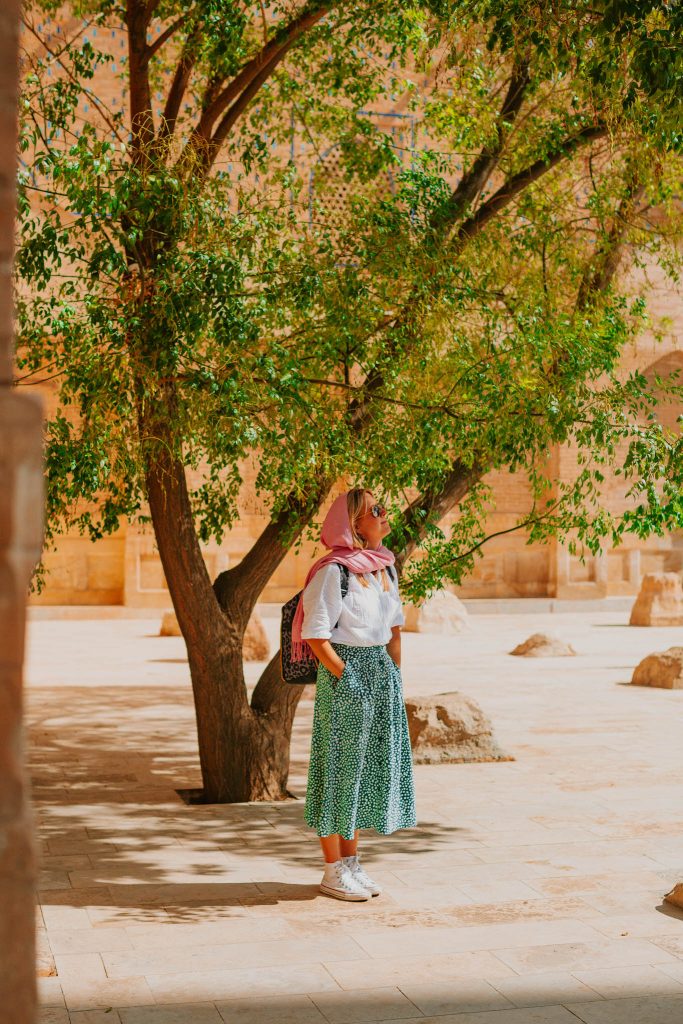Is Bukhara Worth Visiting? Here’s Why It Was Our Favourite City in Uzbekistan
Planning a trip to Uzbekistan and wondering if Bukhara is worth visiting? After spending two days in this historic Silk Road city – as part of our week-long Uzbekistan itinerary – we can confidently say: yes, absolutely.
Before arriving, we knew little about Bukhara beyond its reputation as one of Uzbekistan’s most beautiful and ancient cities. Travelling there by high-speed train from Tashkent, we expected something similar to Samarkand: a place that was busy, layered and surprisingly modern.
What we found, however, was a much more relaxed, walkable and atmospheric destination – a true desert oasis filled with turquoise domes, winding alleyways and Uzbek charm.
Unlike Samarkand, Bukhara still felt like a living, breathing ancient city. While many of its monuments have been carefully restored, they haven’t lost their authenticity or soul – and the small size of the city makes it feel like a secret, desert outpost.
In fact, it turned out to be our favourite destination in Uzbekistan.
So, if you’re wondering what to do in Bukhara – whether that’s visiting ancient madrasahs or bustling bazaars – read on for our list of the 10 best things to do in Bukhara, Uzbekistan.
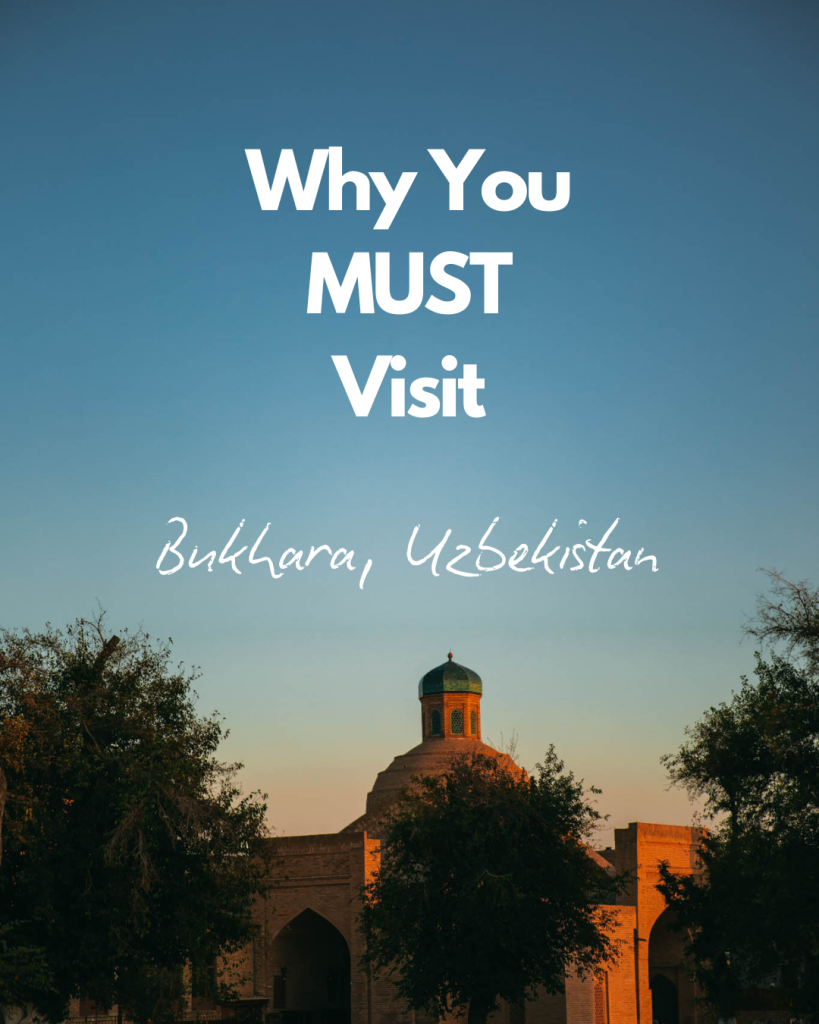
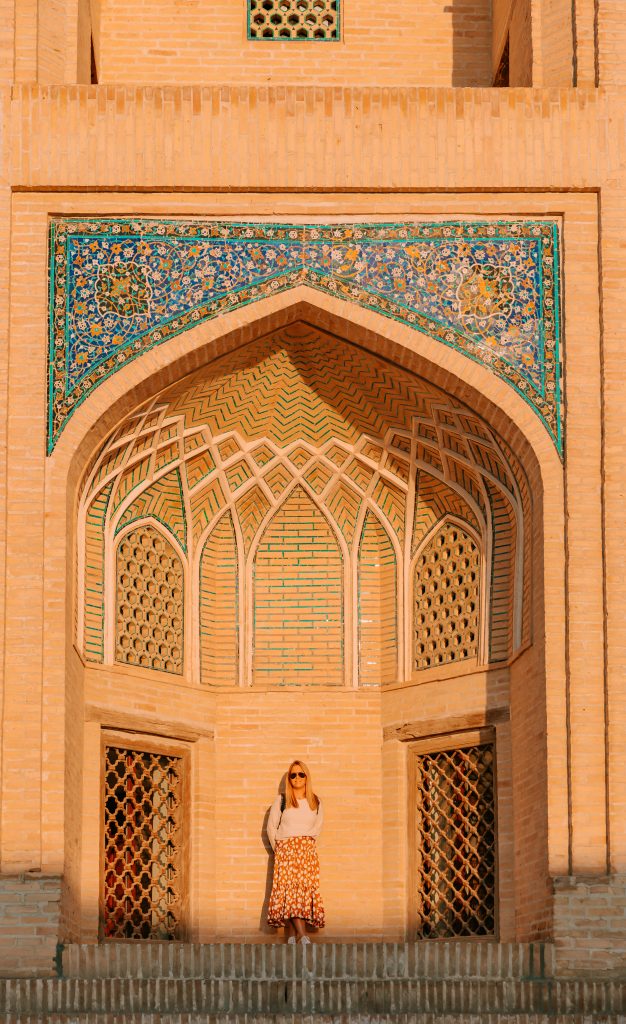
What is Bukhara Famous For?
One reason Bukhara is worth visiting is simply due to its incredible history.
Bukhara is one of the oldest and most culturally significant cities in Central Asia; a place where over 2,500 years of history can be traced through its streets, mosques and monuments.
Founded as early as the 6th century BCE, Bukhara rose to prominence thanks to its strategic location on the Silk Road, serving as a major trading post between East and West. Over the centuries, it became not only a centre for commerce, but a spiritual and intellectual hub of the Islamic world, too.
By the 9th and 10th centuries, Bukhara had become the capital of the Samanid Empire (a Persianate Muslim dynasty). This was a golden age for the city – when it emerged as one of the great centres of Islamic scholarship and learning, rivalled only by Baghdad and Cairo. In fact, the Samanid Mausoleum, built in the 10th century, remains one of the oldest surviving monuments of Islamic architecture in the region.
In the 13th century, the city was attacked by Genghis Khan’s infamous Mongol army, before (thankfully) recovering under the Timurid Empire in the 14th and 15th centuries.
Later, during the 16th to 18th centuries, Bukhara became the capital of the powerful Khanate of Bukhara, which led to another period of architectural and cultural revival. Many of the iconic monuments you’ll see when you visit – including the Kalon Minaret, Mir-i-Arab Madrasa and the Lyabi-Hauz complex – were built during this time.
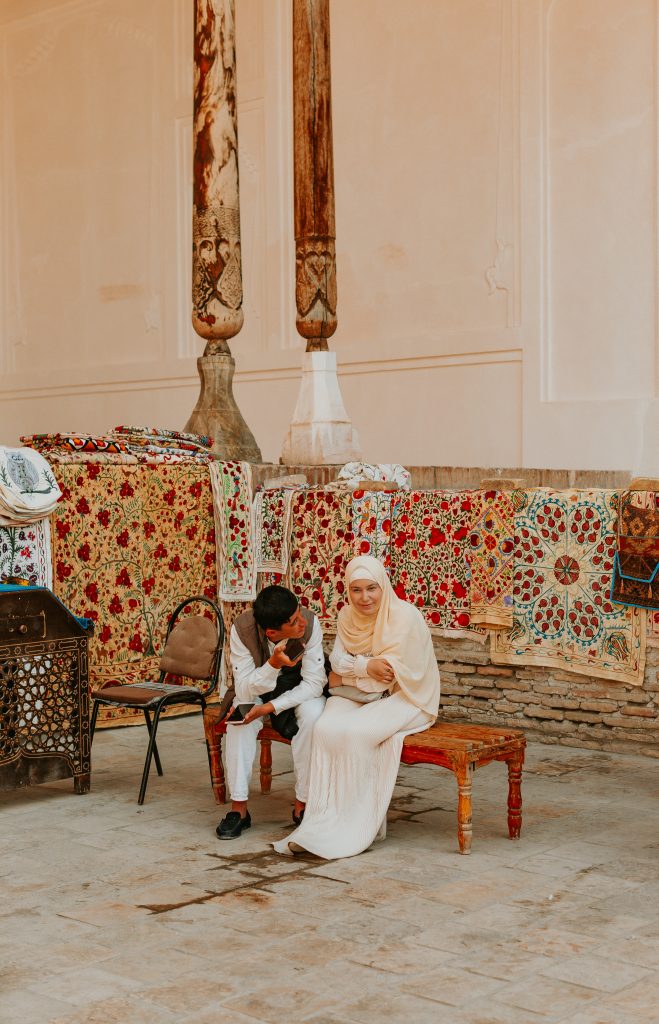
Bukhara remained an important religious centre until it was absorbed into the Russian Empire. Thankfully, and despite Soviet-era changes, much of the old city was preserved and today Bukhara stands out as an amazing example of a living, inhabited medieval city.
Given this incredible (and very long) history, walking Bukhara is therefore like strolling through a living museum. It’s a place where 5th Century buildings continue to be happily inhabited and where daily life continues in the shadows of ancient madrassas.
It really is the most beautiful city in Uzbekistan.
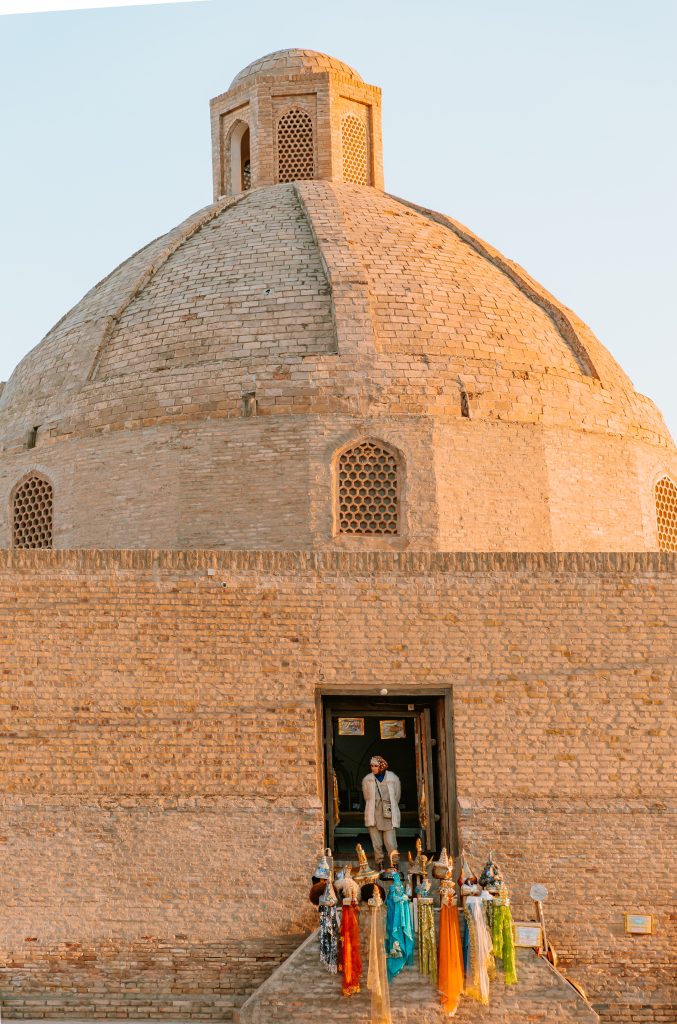
How to Get to Bukhara
Before we tackle places to see in Bukhara, let’s cover the logistics.
Getting to Bukhara is surprisingly easy, thanks to Uzbekistan’s well-developed rail network and affordable transport options. Whether you’re coming from Tashkent, Samarkand or even Khiva, there are a few straightforward ways to reach this historic desert city.
Tashkent to Bukhara by Train
Travelling from Tashkent to Bukhara couldn’t be easier (or more enjoyable) on Uzbekistan’s high-speed train service. We took the ‘Afrosiyob’, a sleek Spanish-built bullet train that turned what we expected to be a tedious 4-hour journey into a genuinely lovely experience.
Far from the overcrowded and chaotic trains we’re used to in the UK, the Afrosiyob offered wide, reclining seats, air conditioning and even a bar carriage where we were unexpectedly handed champagne (yes, really).
We napped, snacked on complimentary treats and watched the Uzbek countryside roll past – all for just £15.
Duration: 3.5 to 4 hours
Cost: approx £10–£15 (depending on carriage class)
Departs from: Tashkent railway station
Arrives at: Kagan Station (20 mins outside Bukhara Old Town)
Tip: Book your tickets in advance, especially during peak travel season (spring and autumn). You can use the official Uzbek Railways website or apps like Yandex Trains or Rail Ninja (for international users).
Samarkand to Bukhara by Train
If you’re travelling the classic Silk Road route through Uzbekistan, chances are you’re heading to Bukhara from Samarkand. Again, the train is probably your best bet here.
The high-speed Afrosiyob train also connects Samarkand to Bukhara multiple times a day, making it a convenient and quick journey.
Duration: 1.5 to 2 hours
Cost: around £6–£10
Frequency: 3–5 departures per day
Tip: Slower Sharq trains are also available, but they’re older and not as comfortable. If you want to save a few pounds, it’s a viable option, though.
Khiva to Bukhara (or Vice Versa)
Getting from Khiva to Bukhara is a bit more complicated, but still manageable.
By Train:
A direct slow train now connects Khiva and Bukhara, though it runs just a few times a week. It’s a long journey, around 8–10 hours, but it’s affordable and can be a good overnight option.
Duration: 8–10 hours
Cost: From £6–£10
Departs: Infrequent – check schedule in advance
By Shared Taxi or Private Car:
Alternatively, you can hire a shared taxi or private driver, especially if you’re traveling with others. By car, the journey between Khiva and Bukhara takes about 6–7 hours, dependent on road conditions.
Duration: 6 hours
Cost: around £10–£15 per seat in a shared car, or £40–£50 for a private car
Tip: If you’re short on time, consider taking a private car with a stop at the Red Desert Caravanserai or Lake Tudakul – it’s a great way to break up the journey.
Getting from Bukhara’s Train Station to the City Centre
If you’re arriving in Bukhara by train, please note that Bukhara’s train station is not actually in the city centre. It’s located in Kagan, about 7.5 miles from Bukhara’s Old Town.
Taxi time: 20 minutes
Cost: around £1.20–£2 (15,000–25,000 UZS)
Drop-off point: Lyabi-Hauz or your hotel
Tip: be prepared to haggle – local taxi drivers will often quote a tourist price first. While the cost is still low by Western standards, it’s worth agreeing on the fare before setting off. Apps like Yandex Go (Uzbekistan’s version of Uber) offer reliable pricing, if you want to avoid awkward negotiation.
How Many Days is Enough in Bukhara?
We spent two full days in Bukhara and honestly – it felt just right.
While there are plenty of places to see in Bukhara, two days gave us the perfect amount of time to explore the city at a leisurely pace, with no rushing between monuments.
We wandered the winding lanes of the Old Town, enjoyed slow lunches in shaded courtyards and even spent an evening unwinding in a traditional hammam (more on that later). It was enough time to see Bukhara’s major sights while still soaking up the city’s atmosphere – which, in many ways, is the real draw.
That said, you could easily stay longer in the city. With its relaxed pace and walkable layout, it would be easy to stretch your stay to three, or even four day – especially if you’re after a slower style of travel.
We said that if we’d booked a hotel with a pool or a shaded garden, we could have happily spent an extra few days reading, sipping tea and watching the world go by.
If you’re on a tight schedule and only have one day in Bukhara, it’s still possible to enjoy its highlights – but we’d highly recommend booking a guided walking tour. A local guide can help you navigate the compact Old Town efficiently, giving you insight into the city’s history while ensuring you don’t miss key sights, like the Po-i-Kalyan complex, Ark Fortress, and Lyab-i-Hauz.
In short:
-
1 day – ideal for highlights with a guide. You’ll get a solid overview, but you’ll be tired (!)
-
2 days – we think this is the sweet spot. Time for sightseeing, long meals and a hammam visit.
-
3 plus days – perfect for slow travel lovers. Time to relax, revisit favourite spots, or take a half-day trip nearby.
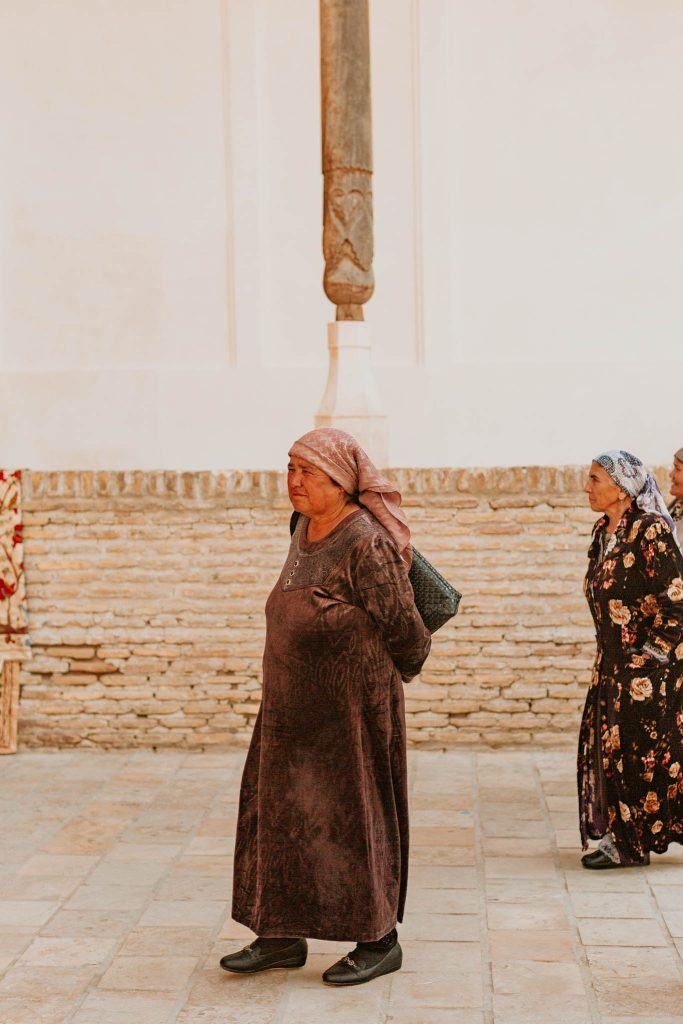
How to Get Around Bukhara: Walking, Rickshaws & Hop-On-Hop-Off Buses
One of the most surprising (and welcome) things about Bukhara is just how walkable it is. Given that there are so many attractions in Bukhara, this is a real blessing – and means your step count doesn’t get too out of hand.
Unlike larger cities like Samarkand or Tashkent, where navigating public transport is necessary, Bukhara’s compact historic centre is definitely best explored on foot.
Staying in or near the Old Town means you can easily walk to the best things to do in Bukhara: including the Kalon Minaret to Lyab-i-Hauz, the Ark Fortress and countless madrasas – all without needing taxis or buses.
We loved the freedom of coming and going from our hotel at our own pace, with no need to worry about transport schedules.
Hop-On-Hop-Off Buses in Bukhara
For those who prefer not to walk long distances (or just want a more structured sightseeing option) Bukhara offers a small fleet of hop-on-hop-off sightseeing buses. These buses operate daily from 9am to 6pm, with departures from Lyab-i-Hauz, the heart of the Old Town.
Tip: Ask your hotel or guesthouse about the latest timetable, as schedules can change seasonally.
Explore Bukhara by Rickshaw
For a more fun and unique way to see Bukhara’s attractions, hop into one of the city’s colourful rickshaws (often motorised tuk-tuk-style). These are especially popular in the Old Town and are a great option if you want a break from walking.
They can often be found waiting near Lyab-i-Hauz and major tourist spots
When is the Best Time to Visit Bukhara (or Uzbekistan)?
We visited Bukhara at the end of October, when the weather was still warm – but the trees of the city were turning a deep orange.
Personally, we think autumn was the best time to visit Uzbekistan, when the heat of the summer had faded but the warm autumn sun still made it incredibly pleasant to explore during the day, in just a t-shirt and jeans.
The evenings were a lot colder than the days, however, and we needed to wrap up considerably more with plenty of layers and a coat at night.
The spring months of April to early June are also a pleasant time to visit Bukhara, with similar temperatures to autumn.
In terms of whether you should visit Uzbekistan in summer, we would say (definitively) – ‘no’. Temperatures often soar to 40 degrees and sight-seeing would be slow, sweaty and miserable.
If you’re keen not to visit during the peak seasons of spring and autumn, winter in Bukhara is perhaps do-able, albeit very cold – with temperatures dropping to -15 degrees. Our guide assured us, however, that the city is beautiful during this time – with snow covering the ancient monuments, creating picture-perfect scenes.
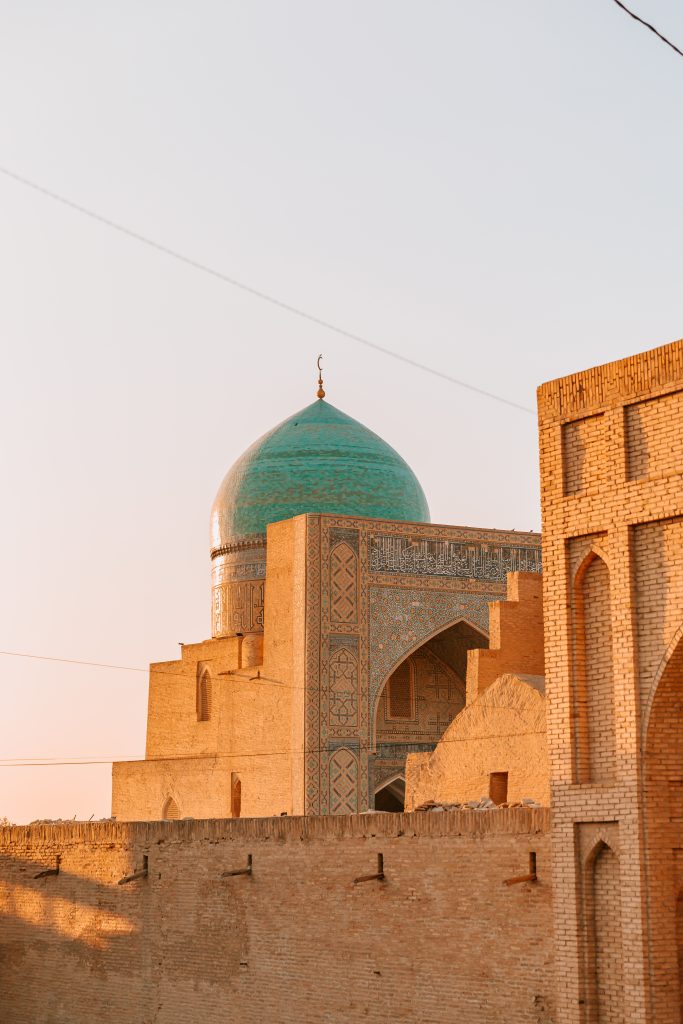

What’s the Best Hotel in Bukhara?
During our visit to Bukhara, we stayed at the conveniently located Hotel Malika Bukhara. Located in the heart of the city, it was a comfortable 4* hotel with terrace and balconies, a good breakfast and free WIFI.
From our base, we could explore the city by foot and enabled us to make the most of our time in the city.
Looking for something else? Browse the best hotels in Bukhara.
10 Best Things to do in Bukhara, Uzbekistan
Although this sand-coloured city is fairly small compared to the likes of Tashkent, there are still plenty of places to see in Bukhara. Below is our Bukhara travel guide.
1. Visit the Ark Fortress
One of the best places to see in Bukhara is undoubtedly the Ark Fortress.
This is perhaps the best known attraction in the city – and Bukhara’s oldest building. Built in the 5th century as a royal town-within-a-town and fortress, the Ark was used until the 1920s, before it was bombed by the Red Army and taken by Russia.
Traditionally, the Ark was home to the emirs of Bukhara (rulers), with an entire community living and working within the Ark. Unfortunately, 80% of the buildings were bombed in the 1920s but there are still many rooms to explore, which have since been turned into museums.
The preserved sections have been restored and now house a number of small museums, including exhibitions on Bukhara’s royal history, weaponry and Islamic calligraphy.
In terms of what to do in Bukhara – a trip here is a must. It’s a fascinating place to visit and offers some amazing views of the city.
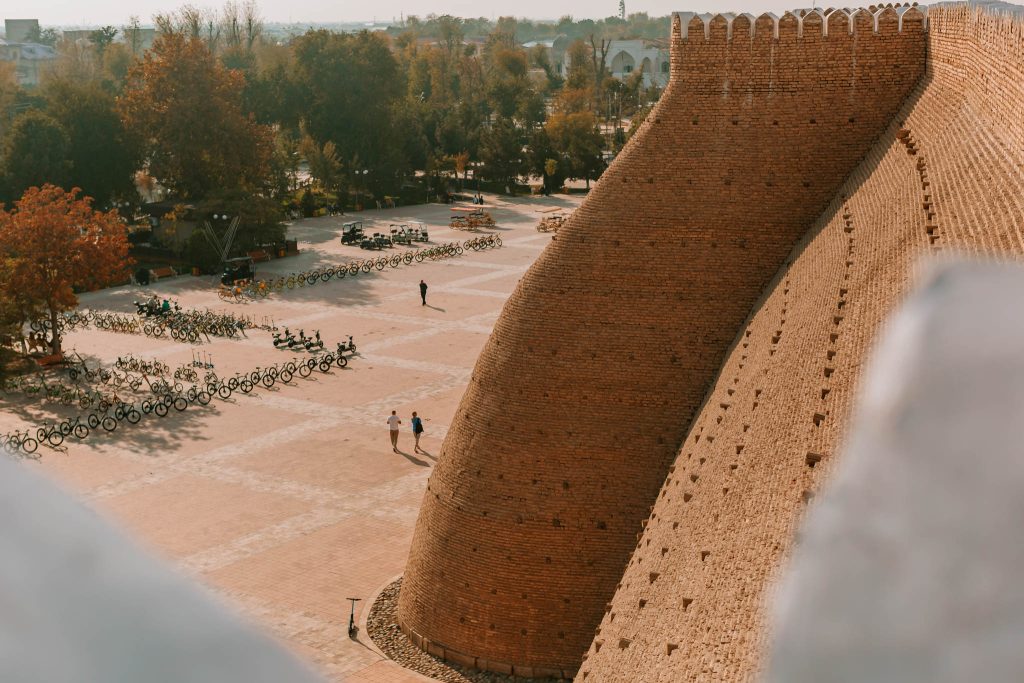
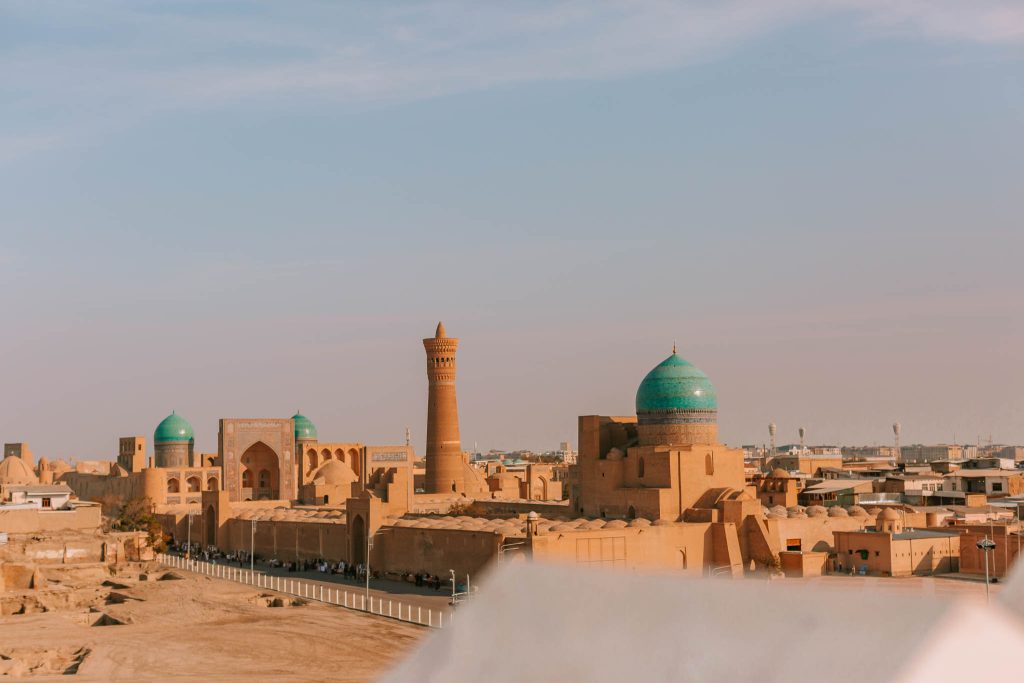
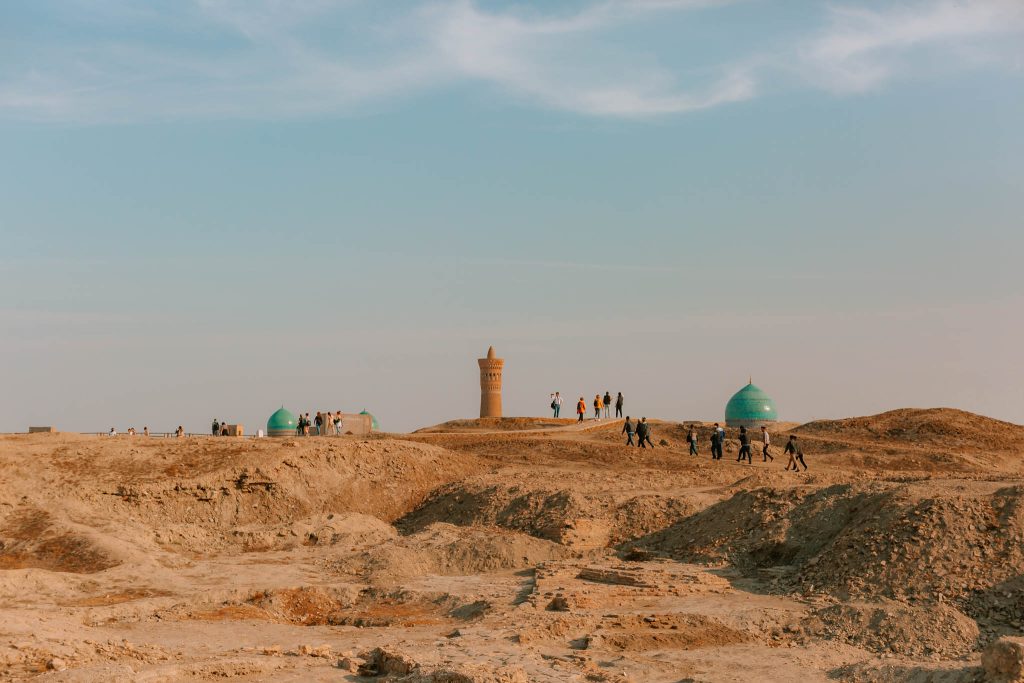
2. Explore Lyab-i-Hauz Ensemble
One of the most atmospheric places to visit in Bukhara is the beautiful Lyab-i-Hauz Ensemble – a peaceful square built around a leafy pond in the heart of the Old City.
Despite being surrounded by desert, Bukhara is actually part of a natural oasis and Lyab-i-Hauz reflects this beautifully with its shady trees, historic madrassas and emerald-green waters.
The name “Lyab-i-Hauz” translates from Persian to ‘by the pond’ and centuries ago, Bukhara was filled with these small reservoirs. Back then, the ponds weren’t just practical – they supported a whole ecosystem. During the summer, stagnant water would attract flies, which brought in frogs, which in turn attracted storks – Bukhara’s iconic bird.
Storks became so symbolic of the city that you can still spot their old nests preserved on top of buildings, as well as stork-themed monuments and souvenirs throughout the city (including the famous Bukhara scissors – shaped like storks).
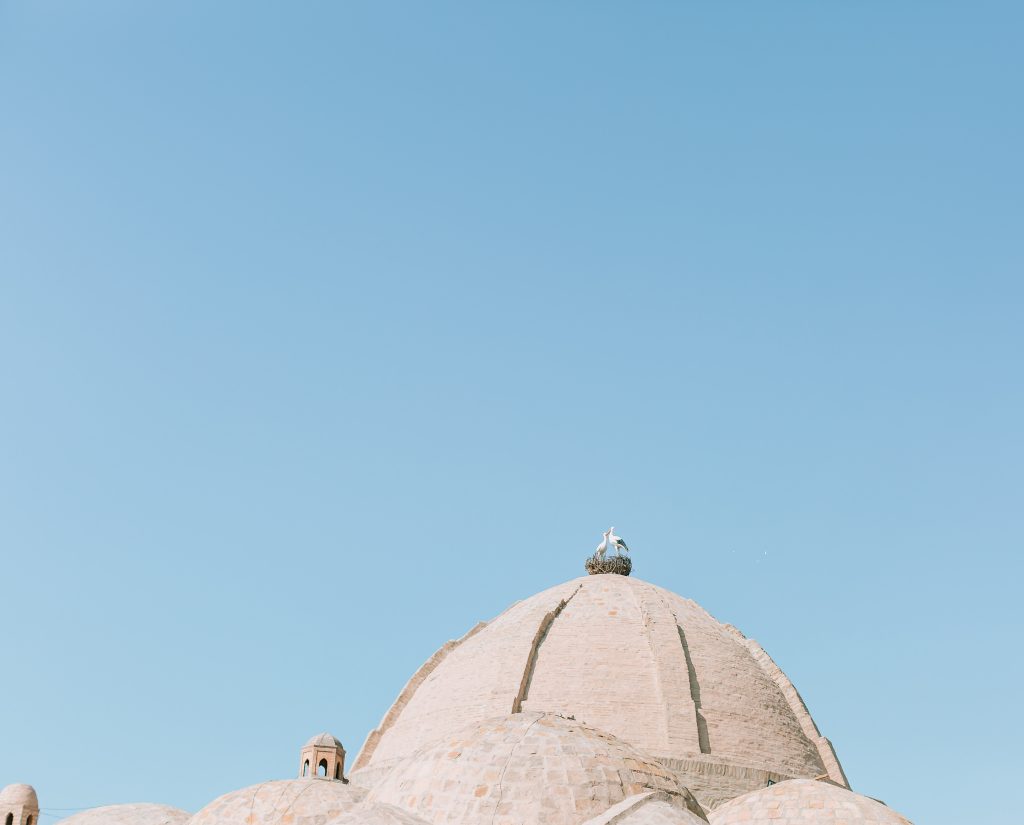
Unfortunately (for the storks), many of Bukhara’s ponds and marshes were drained in the 20th century to prevent malaria outbreaks, breaking the fly-frog-stork cycle. While storks no longer roam the city, you can still pick up a gorgeous pair of Bukhara stork scissors from local blacksmiths.
Beyond its fascinating history, Lyab-i-Hauz is also one of the most vibrant and social spaces in the city. It’s surrounded by restaurants, tea houses and artisan shops – making it a perfect spot to relax between sightseeing stops. At the northern end of the square sits the Madrassah of Nadir Divan-Begi, a stunning building with rare animal imagery in its tilework (an interesting exception to Islamic artistic tradition).
A visit to this part of the city is definitely one of the best things to do in Bukhara.
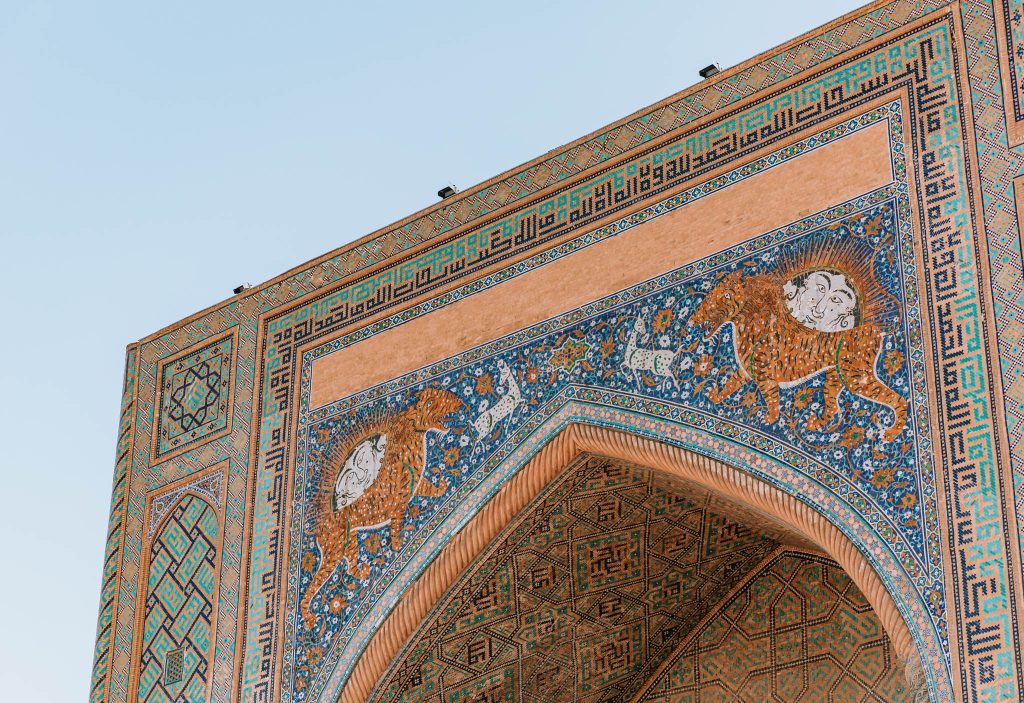
3. Bolo Khauz Mosque
One of the most beautiful places to see in Bukhara is the elegant and distinctive Bolo Haouz Mosque: a striking example of traditional Islamic architecture, with a unique wooden twist.
Located just opposite the Ark Fortress, this 18th century mosque was built in 1712 and is instantly recognisable thanks to its twenty intricately carved wooden columns, which support a painted iwan (porch ceiling).
Unlike many grand stone mosques across Central Asia, Bolo Haouz is much more delicate – and definitely the most photogenic and unique mosques in Uzbekistan.
The name ‘Bolo Haouz’ means ‘children’s pond’ – which refers to the small reservoir beside it. It’s the perfect spot for photography, especially in the early morning or during golden hour.
This site is also part of the UNESCO-listed Historic Centre of Bukhara, and remains an active place of worship.
When we visited during the midday call to prayer, we stood quietly in the square, watching locals arrive in a steady stream. As the ‘adhan’ echoed across the old city and the sun warmed tour backs, we felt incredibly lucky to be visiting this stunning city.
An hour spent here is definitely one of the best things to do in Bukhara.
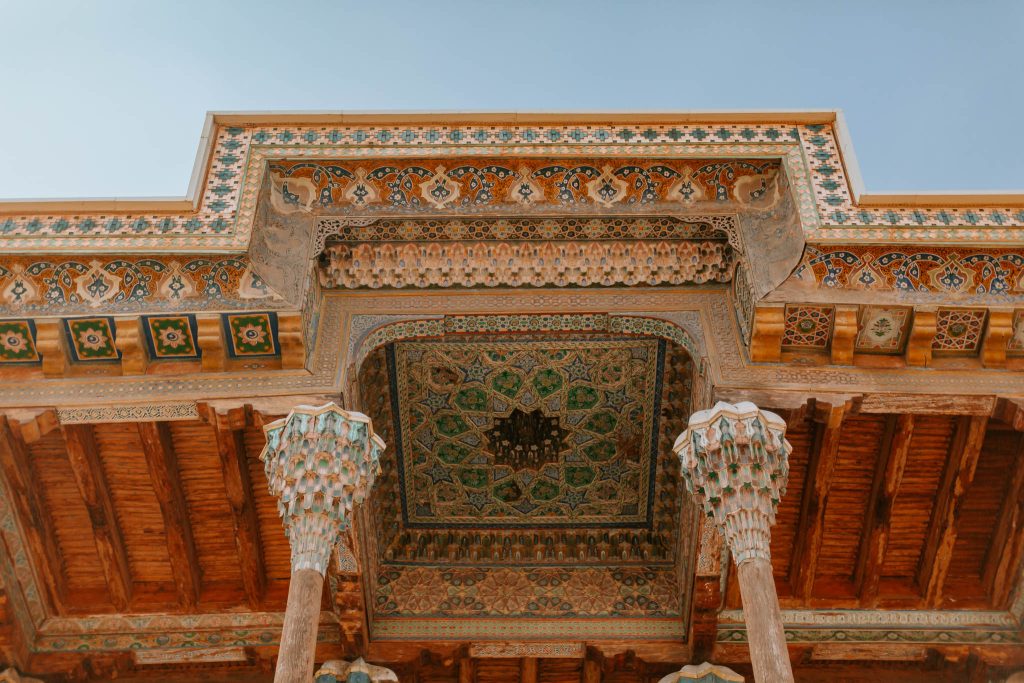
4. Shop in the Domed Bazaar of Bukhara
No visit to Bukhara is complete without a stroll through its Domed Bazaar – one of the most atmospheric and historically significant places to see in Bukhara.
Once a bustling centre of Silk Road trade, these covered marketplaces – known as trading domes or ‘Toks’ – were where merchants once exchanged silk, spices, ceramics and gold from across Central Asia and beyond.
Today, although the frenetic atmosphere of the old Silk Road days has faded, the Old Bazaar is a vibrant and fun place to shop. Inside the cool shade of the domes, you’ll find a maze of stalls selling everything from handwoven rugs and embroidered suzanis, to silk scarves, ceramics, miniature paintings and fragrant Uzbek spices.
Haggling is still very much part of the experience. I managed to knock £20 off a beautiful rug and another £5 off a hand-dyed silk scarf, just by negotiating. Vendors expect it, so don’t be shy.
Tip: the architectural details of the domes themselves are worth looking at, especially Toqi Sarrafon, Toqi Telpak Furushon, and Toqi Zargaron.
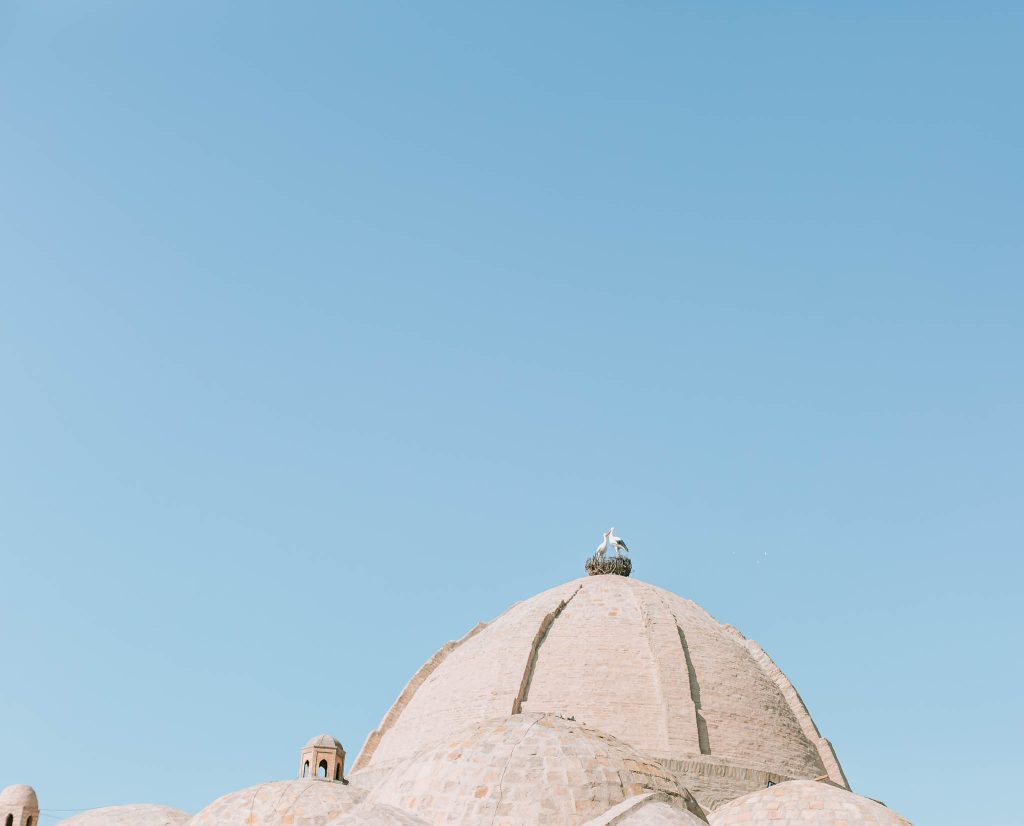
5. Samanid Mausoleum
Among the most important historical places in Bukhara, the Samanid Mausoleum stands out for its story of survival.
Built in the 10th century, this small (yet beautiful) structure is the final resting place of members of the Samanid Dynasty, who ruled parts of Central Asia between 819 and 999 AD.
What makes the Samanid Mausoleum unique is not just its striking baked-brick design, but the fact it was buried under layers of mud after a flood, effectively hiding it from view for centuries. This then (luckily) spared it from destruction during the Soviet era and it wasn’t uncovered until excavations in 1934.
Today, the mausoleum sits peacefully in Samanid Park, surrounded by shady trees, ponds and wandering ducks. There’s even a small amusement park nearby, making it a great place to unwind after a day of sightseeing.
Getting there: the mausoleum is a short walk from the Ark Fortress and Bolo Haouz Mosque, making it easy to combine with other top attractions in Bukhara.
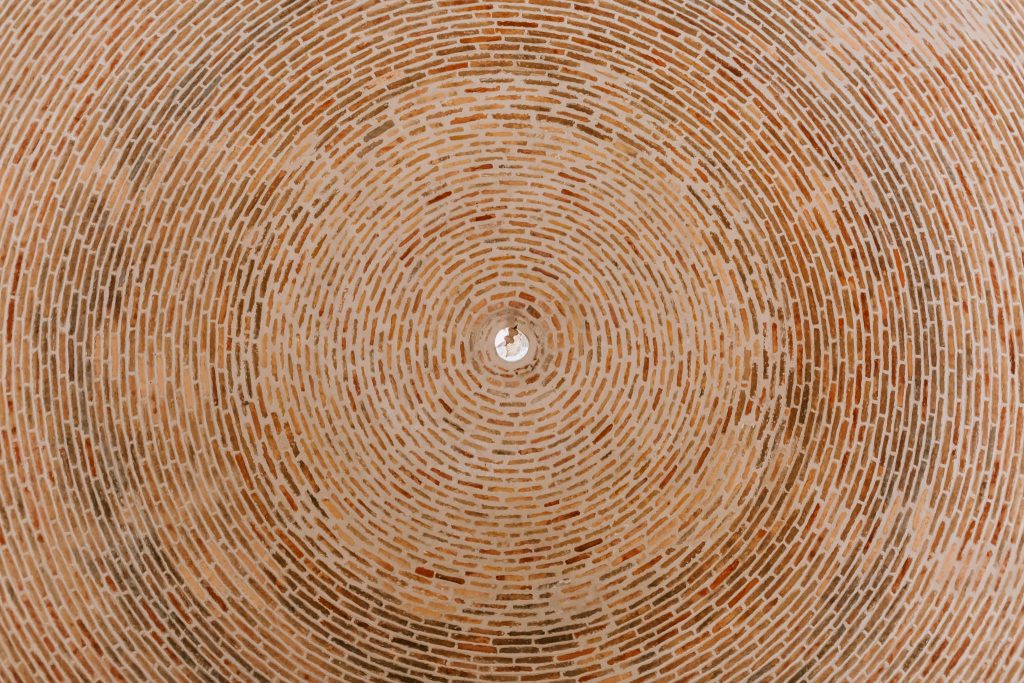
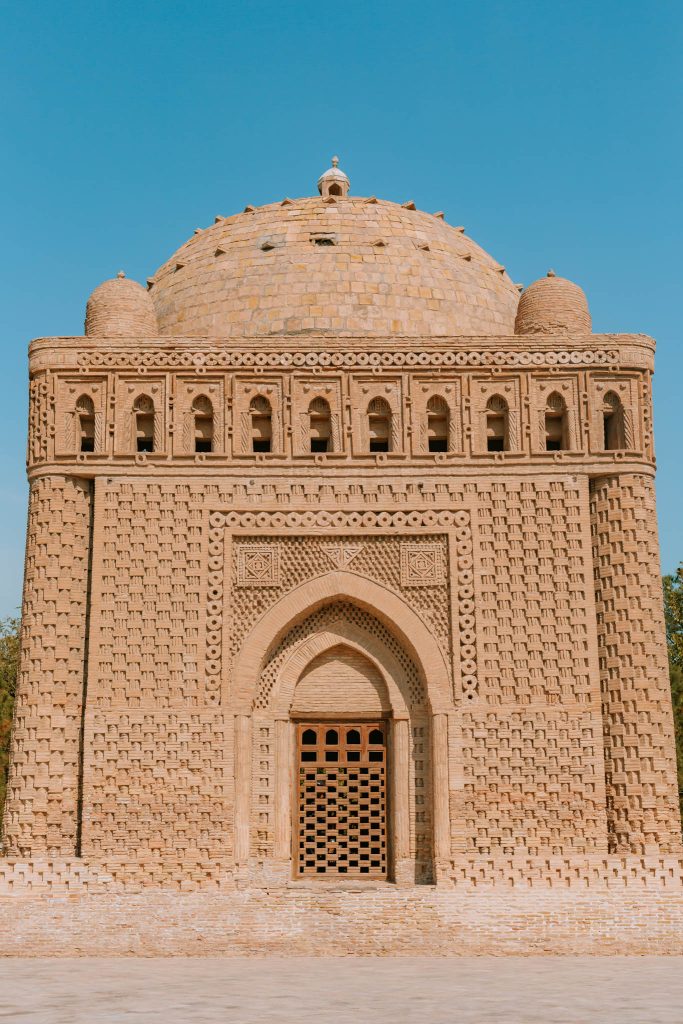
6. Po-I-Kalyan Ensemble
If you’re looking for the most iconic place to visit in Bukhara, the Po-i-Kalyan Ensemble is it.
Located in the heart of the Old City, this breathtaking complex is the postcard image of Bukhara – and a must-see for any visitor.
The ensemble includes three magnificent structures: the Kalyan Mosque, the Miri-Arab Madrassah, and the soaring Kalyan Minaret – one of the most recognisable monuments in all of Uzbekistan. Together, they form one of the most impressive examples of Islamic architecture in Central Asia.
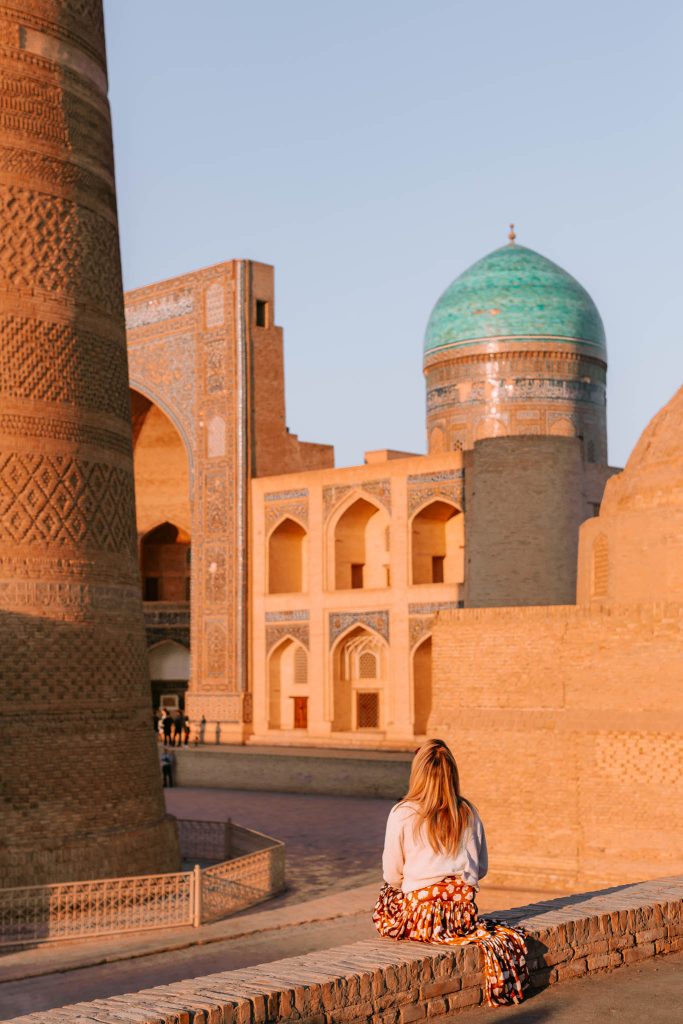
The Kalyan Minaret, standing at 47 metres tall, was built in 1127 AD and has dominated Bukhara’s skyline for nearly 900 years. It’s so beautiful that even Genghis Khan, known for destroying entire cities, spared it from destruction when he conquered Bukhara.
Directly opposite the minaret is the Kalyan Mosque, a vast open courtyard.
It’s especially beautiful in the early morning light, when the rising sun casts a warm glow across the tiled walls and domes. Entrance costs around 20,000 UZS, but if you visit just after sunrise, before official hours, you may be able to enter freely and enjoy the space without the crowds.
Opposite the mosque is the Miri-Arab Madrassah, still a functioning Islamic school and not open to visitors, but stunning from the outside.
Tip: women must cover their heads to enter the mosque. Bring a scarf in your day bag so you’re always prepared.
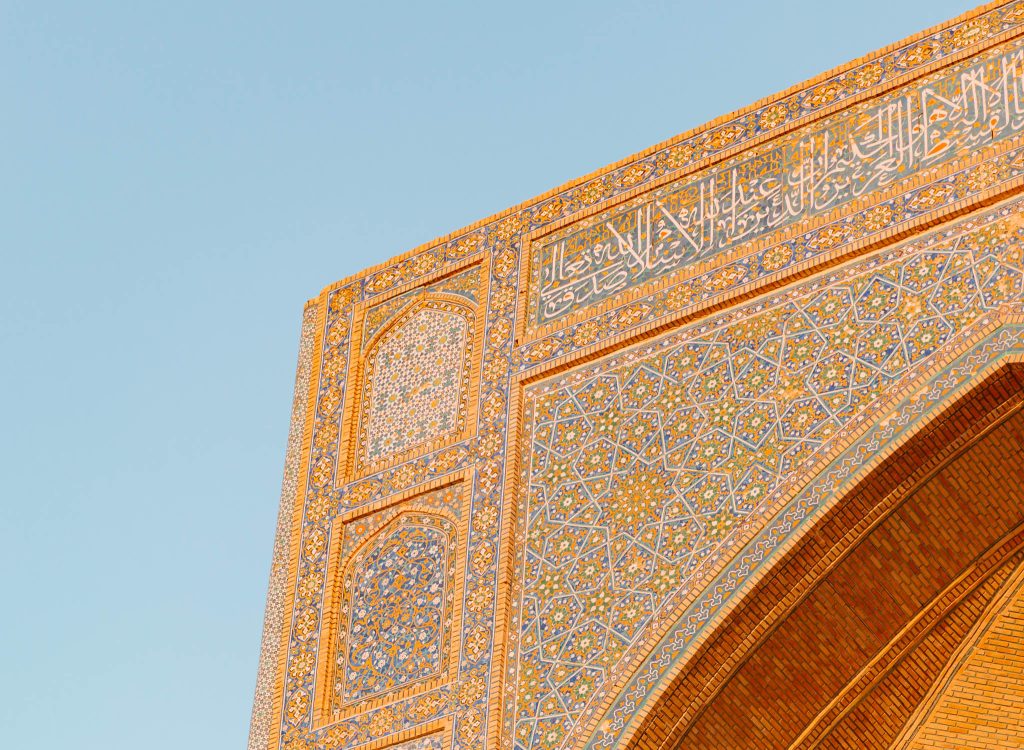
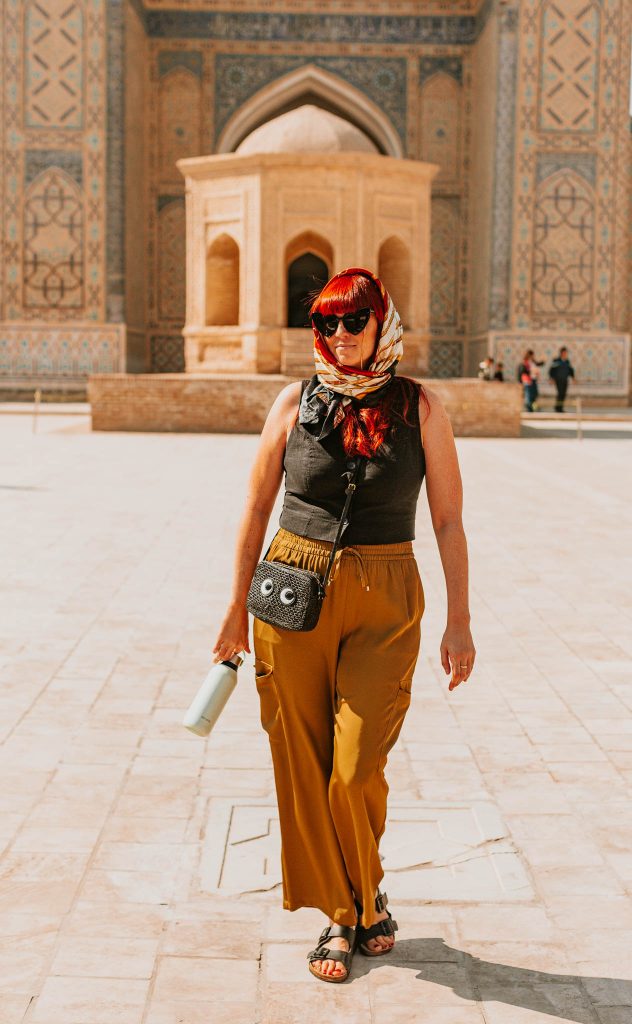
7. Visit Chor Minor Madrassah
One of the more unusual things to do in Bukhara is a visit to the pretty and slightly surreal Chor Minor Madrasa. This small, but unforgettable structure, is tucked away in a quiet corner of the Old City.
Built in 1807, Chor Minor (meaning ‘Four Minarets’) was originally the gatehouse to a now-lost madrasa. Today, it stands alone as a postcard-perfect monument, instantly recognisable for its four decorative towers, which resemble little blue-domed pepper pots.
Although it’s no longer a functioning religious building, it remains one of the prettiest places in Bukhara.
Inside, Chor Minor now hosts a small souvenir shop, and for a small fee, you can climb one of the towers for rooftop views over the surrounding neighbourhood.
Just outside, you’ll find a cluster of stalls selling Soviet-era memorabilia, including vintage stamps, propaganda pins and black-and-white photographs of pre-Soviet Bukhara. We picked up some unique little gifts here that made for meaningful (and very portable) souvenirs.
Tip: Chor Minor can be tricky to find – it’s tucked into a residential area. Google Maps will get you close, but don’t be afraid to ask a local if you get lost.
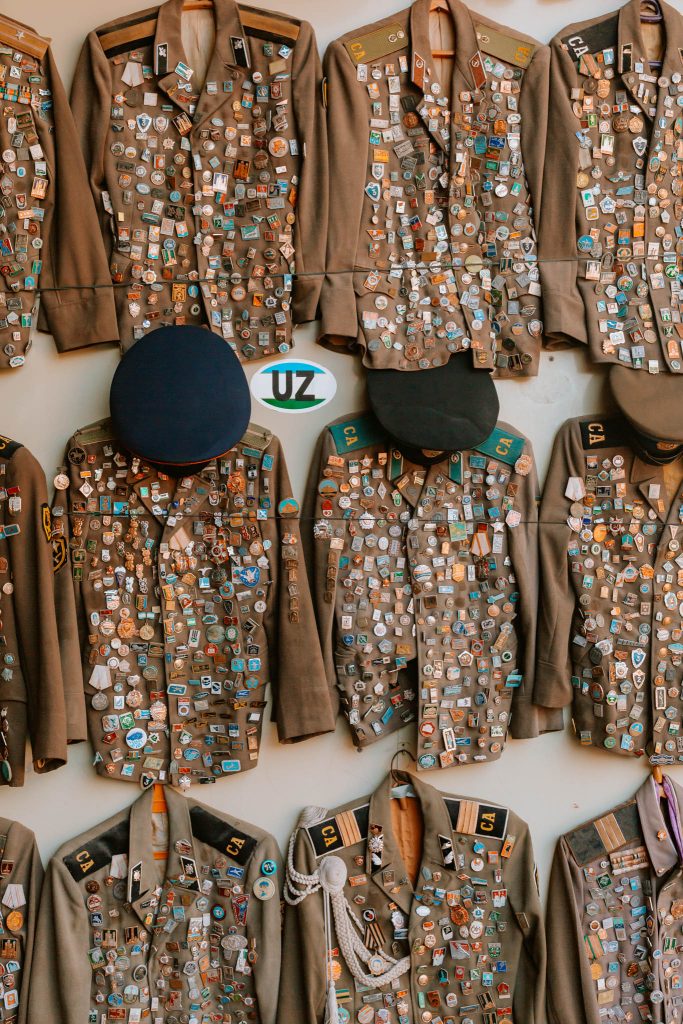
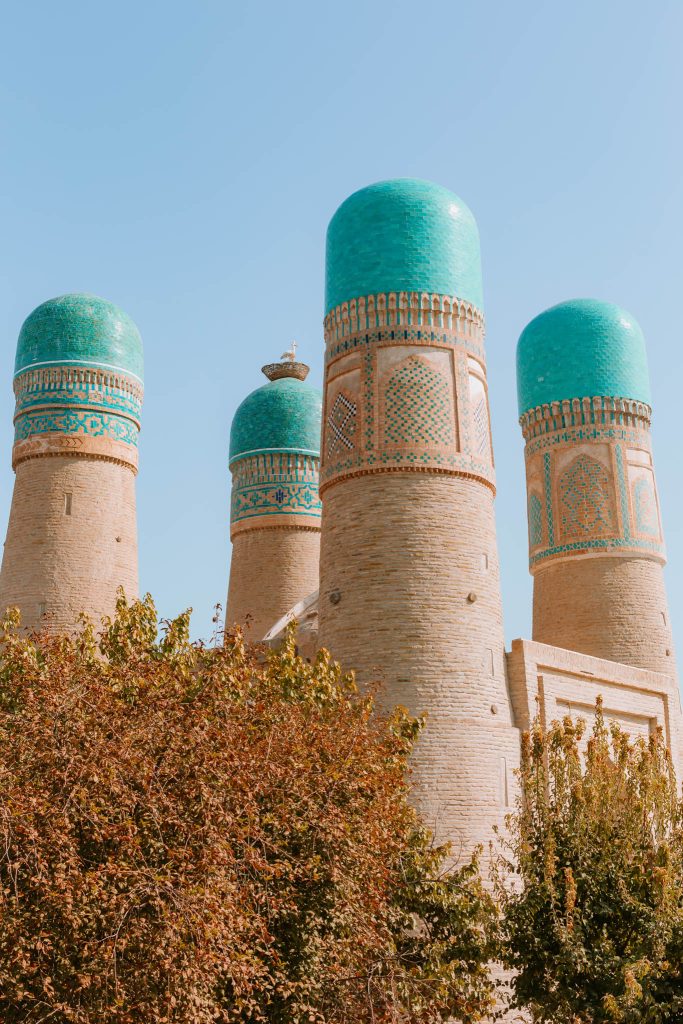
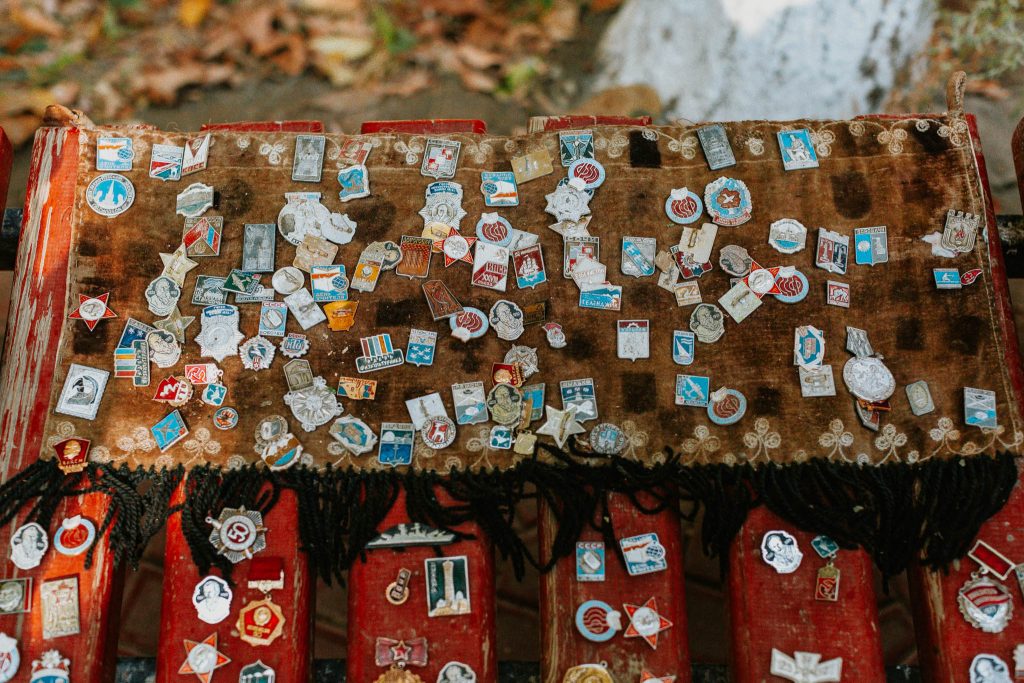
8. Visit Abdulaziz Khan Madrassah
One of the most impressive attractions in Bukhara, the Abdulaziz Khan Madrassah is a must-visit for architecture lovers.
Built in 1652, this madrassah showcases the Timurid-era design that makes Bukhara so visually unique.
Often regarded as the most beautiful madrassah in Bukhara, the building features a breathtaking facade of glazed tiles, geometric mosaics and intricate floral motifs. Inside, you’ll find richly decorated prayer halls, muqarnas ceilings and quiet courtyards that still retain a peaceful, almost spiritual, atmosphere.
To fully appreciate its beauty and avoid the crowds, aim to visit before 9am, when the shops and tour groups haven’t yet arrived.
At that hour, the madrassah glows in the soft morning light, and you’ll likely have the place to yourself. A visit here is definitely one of the best things to do in Bukhara.
Tip: don’t miss the chance to compare it with the Ulugh Beg Madrassah directly opposite – the contrast in design tells a fascinating story about changing artistic styles and rulers in Bukhara’s history.
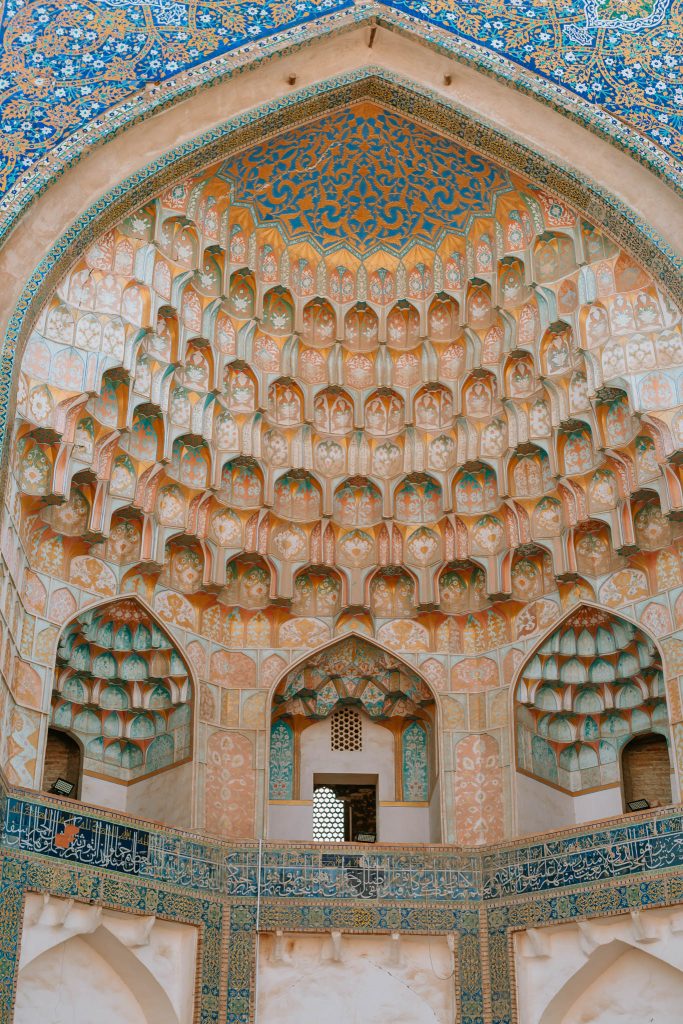
9. Enjoy the City at Sunset
One of the most magical things to do in Bukhara is to explore the city as the sun begins to set. Wandering the old streets in the golden light of evening is a truly unforgettable experience.
As we left our hotel and wandered through the quiet alleyways, the sky lit up with swallows darting overhead. Rounding the corner into Po-i-Kalyan Square, we were stunned into silence: the Kalyan Minaret and Mosque glowed a deep honey-gold and their details were made even more dramatic by the low sun.
It felt more like stepping onto a carefully crafted film set than into a working, living city.
The soft atmosphere of sunset in Bukhara transforms the city. The crowds disperse, the air cools and the architecture comes to life in a whole new way. It’s a great time for slow walks and, of course, photography.
Tip: For the best sunset views in Bukhara, head to Chasmai-Mirob Restaurant, perched above the Po-i-Kalyan complex. Order a tea, cocktail or cold beer and enjoy uninterrupted views as the sun sets over one of Uzbekistan’s most iconic landmarks.
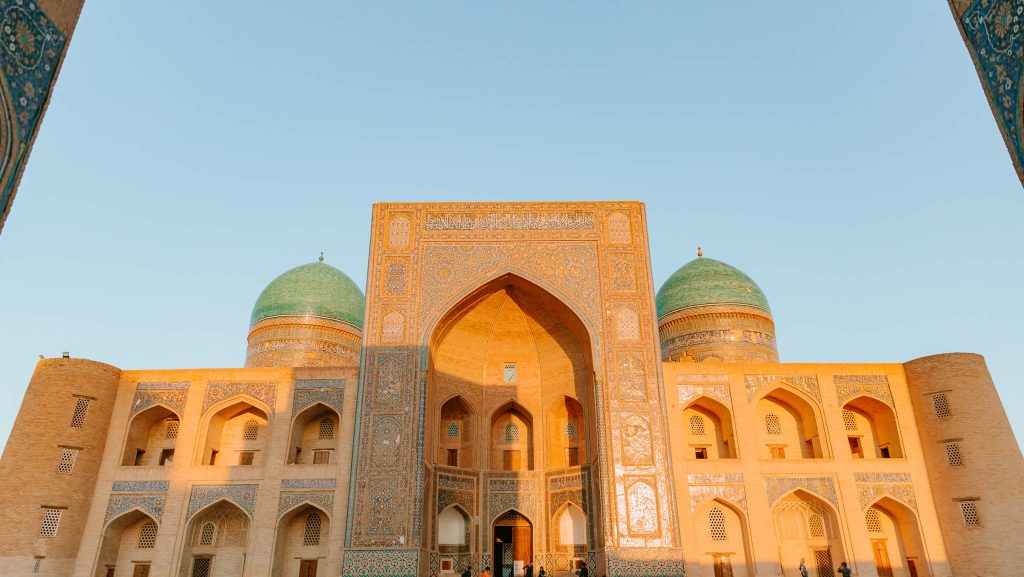
10. Enjoy a Hammam in Bukhara
It might seem a little unexpected to end a list of the best things to do in Bukhara with a trip to the local hammam, but trust us: this is an experience you won’t forget.
We’ve visited hammams all over the world – from Morocco to Turkey to Jordan – and thought we knew what to expect. Uzbekistan, however, had other plans. What unfolded was less a relaxing spa experience and more of a bold cultural rite of passage.
Descending into a steamy, cave-like underground complex, we were promptly told to strip. As a group of 16 women who’d only just met, this was an intimate icebreaker, shall we say.
Shuffled into a stone chamber under the stern gaze of a no-nonsense hammam attendant, we were scrubbed, rinsed, and washed within an inch of our lives – all in full view of each other.
Laid out on heated slabs, bathed like babies and thoroughly exfoliated, we emerged both shell-shocked and sparkling clean. It was surreal, awkward, hilarious – and kind of magical.
Tip: Looking for a truly unique thing to do in Bukhara? Book a hammam. It’s a brilliant way to bond with your travel companions.
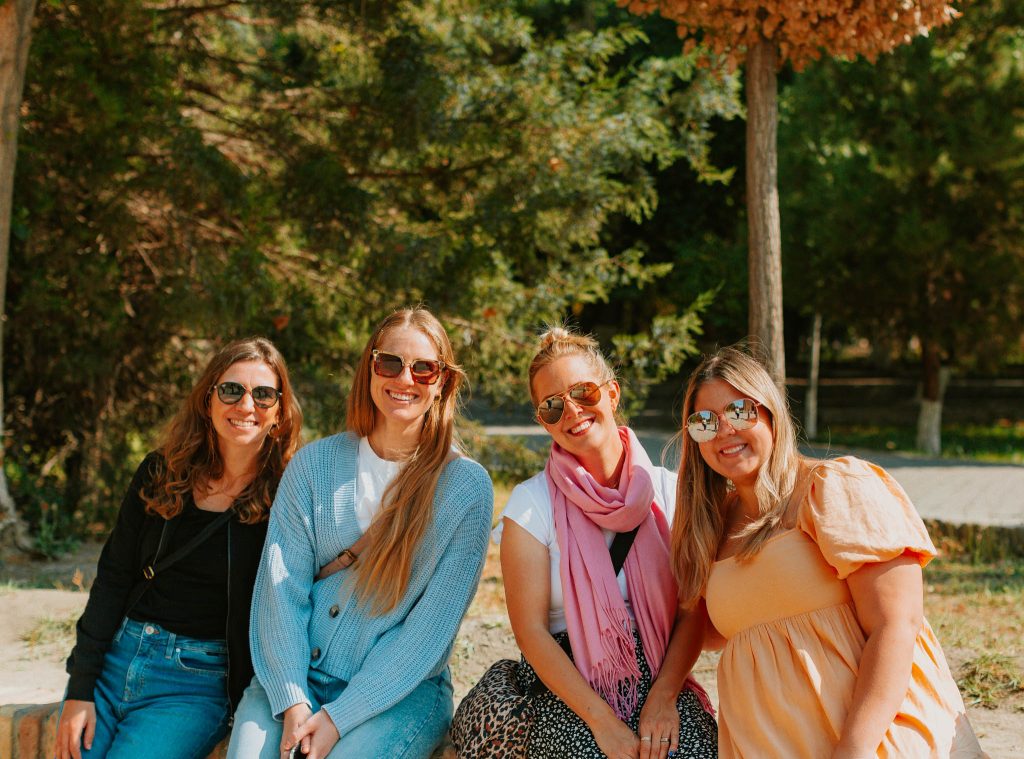
Which is Better: Samarkand or Bukhara?
While we really enjoyed both cities, there was something about Bukhara that stayed with us: a sense of quiet charm and authenticity that we didn’t find in Samarkand.
Samarkand is undoubtedly impressive. Its scale, grandeur and monumental beauty are breathtaking, and there’s no denying that its iconic landmarks are perhaps the most striking in Central Asia.
However, for us, the experience sometimes felt a little too polished and bureaucratic. It was also very spread out – and we found ourselves relying more on taxis and public transport to get around, which interrupted the flow of exploring.
Bukhara, on the other hand, is intimate. The historic centre is compact and incredibly walkable, which allowed us to explore at our own pace without the need to constantly plan how to get from A to B.
We’d wander out from our hotel in the morning, explore winding backstreets, stumble across quiet courtyards and shaded madrassas, and return again in the evening. Every day felt easy, relaxed and pretty magical.
What also stood out to us was how ‘lived-in’ Bukhara felt. While parts of it have been restored, the city hasn’t lost its soul at all. Locals still gather around Lyab-i-Hauz to chat and drink tea, and it’s clear that the Old Town isn’t just for tourists – it’s very much a working city.
In short, Bukhara surprised us. Before visiting Uzbekistan, we honestly thought we would prefer Samarkand – given that so many people raved about its beauty and ‘wow’ factor. However, Bukhara had a more authentic, peaceful atmosphere that captured Uzbekistan’s character – unlike the crowds and tour buses of Samarkand.
So, if you were to ask us – which is better to visit, Bukhara or Samarkand – we would absolutely vote Bukhara.
Samarkand vs Bukhara: Which is Best?
| Feature | Samarkand | Bukhara |
|---|---|---|
| Architectural scale & spectacle | Massive, grand monuments — think the Registan, Gur-e-Amir, huge mosques, lavishly tiled madrassas. Your eyes are constantly drawn upward to scale and symmetry. | More intimate, walkable architecture – beauty is tucked into alleys, courtyards and everyday corners. The Po-i-Kalyan ensemble, Lyab-i-Hauz, and other sites feel more accessible. |
| Atmosphere / character | Big, bustling, with modern city traffic and a contrast between historic and newer districts. You feel the weight of history, but also the hustle of a regional hub. | Quieter, more relaxed. We found Bukhara to feel more ‘lived-in’ – less theatrical and more genuine. We think it is the best city in Uzbekistan. |
| Walkability & exploring by foot | You’ll need public transport or taxis more (especially if your highlights are spread out). Some historic spots are farther apart. | Very walkable, especially in the Old Town. You can wander, rest and loop back. You’re less dependent on transport. |
| Depth & layers of history | Deep and rich – Samarkand has layers from Alexander the Great, Mongol destruction, to Timurid grandeur, Soviet additions and modern reinvention. | Also extremely historic (over 2,500 years), but many of its layers are more subtly woven into daily life. Restoration in Bukhara has been done with a lighter touch. |
| Highlight ‘must-see’ attractions | Registan, Shah‑i-Zinda, Bibi-Khanym, Gur-e-Amir – dramatic, monumental highlights. | Ark Fortress, Po-i-Kalyan, Lyab-i-Hauz, Chor Minor, the bazaar, hammam experience – the more ‘immersive’ side of heritage. |
Day Trips and Excursions from Bukhara
While Bukhara itself is absolutely worth visiting, the surrounding region is packed with fascinating day trips and excursions.
1. Sitorai Mohi Hosa Palace
Just a short drive from Bukhara’s city center, this former summer palace of the last Emir of Bukhara blends traditional Uzbek architecture with European influences.
Nestled in gorgeous gardens, the palace is a peaceful retreat filled with elegant interiors and fascinating exhibits. It’s a great place to learn more about Bukhara’s royal history and enjoy a relaxing walk away from the city’s bustle.
Distance: About 5 km (10 minutes by car)
2. Gijduvan Village
For those interested in traditional crafts, a trip to Gijduvan village is a must.
Located around 40 km from Bukhara, this village is famous for its beautiful blue-glazed pottery and ceramics. You can visit workshops, watch artisans at work and even try your hand at creating your own piece. It’s a hands-on cultural experience and a fantastic way to bring home a truly unique souvenir.
Distance: 40 km (about 1 hour by car)
3. The Desert and Chor Bakr Necropolis
Venture out into the desert surrounding Bukhara to visit the Chor Bakr Necropolis, a significant religious site and complex of mausoleums that date back centuries.
It’s a serene and spiritual place that offers insight into Islamic architecture and local traditions. The surrounding desert landscapes also provide excellent opportunities for photography.
Distance: around 7 km from Bukhara (15 minutes by car)
4. Nurata Mountains and Aydarkul Lake (Overnight Option)
If you have more time, consider a longer excursion to the Nurata Mountains and Aydarkul Lake, located about 3-4 hours from Bukhara.
Here, you can explore stunning natural landscapes, go hiking and visit ancient petroglyphs. The area is also home to nomadic communities where you can experience traditional Uzbek hospitality.
Where to Eat in Bukhara: 6 Great Places to Try Local Cuisine
Minzifa Restaurant: A favourite with travellers, this rooftop restaurant serves beautifully presented Uzbek classics with views over the Old City.
Chasmai-Mirob: Perfect for dinner with a view. Enjoy plov and shashlik while watching the sun set over the Po-i-Kalyan Ensemble.
Old Bukhara Restaurant: Tucked into a traditional courtyard, this cosy spot offers hearty portions and an authentic atmosphere.
Ayvan Restaurant (at Komil Boutique Hotel): set in a gorgeously restored caravanserai, this is ideal for a romantic dinner or a slow lunch.
Tea & Coffee Khona: For a mid-morning break or post-hammam refreshment, stop here for local tea, sweets and people-watching near Lyab-i-Hauz.
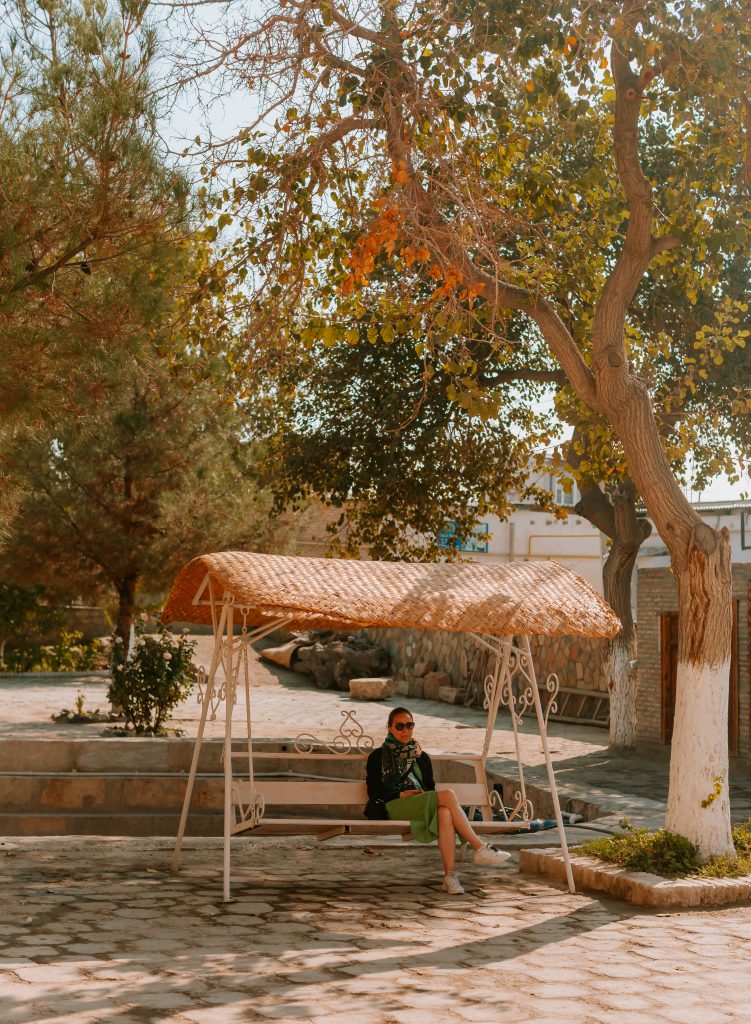
Final Thoughts: Is Bukhara Worth Visiting?
After spending time wandering its ancient streets, soaking in its rich history and experiencing the slow rhythm of daily life, we can say with absolute certainty – yes, Bukhara is worth visiting.
This city isn’t just a stop on the Silk Road: it’s a living, breathing museum of Central Asian culture. From the imposing Ark Fortress to the tranquil Lyab-I-Hauz pond, and the bustling domed bazaars, Bukhara offers a unique blend of history, beauty and authenticity that feels rare elsewhere.
Whether you’re exploring by foot, enjoying the sunset from a rooftop cafe, or indulging in a traditional hammam, Bukhara invites you to slow down and discover a side of Uzbekistan that’s incredibly special.
If you’re planning your trip to Uzbekistan, don’t overlook this desert oasis – Bukhara is (in our opinion) the best place to visit in Uzbekistan.
